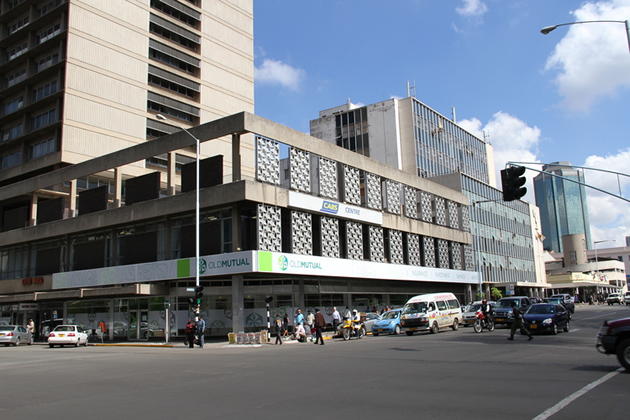Old Mutual declares $10m dividend

 Tinashe Makichi Business Reporter
Tinashe Makichi Business Reporter
Old Mutual Zimbabwe has declared a $10 million dividend for its shareholders for the year ended December 2013. The group in the same period posted positive results recording a 2000 percent increase in profit.
At least $2, 5 million which is 25 percent of the declared dividend will go to the locals as part of the company’s indigenisation plan.
Speaking at the company’s Annual General Meeting yesterday in Harare, OMZL chairman Mr Johannes Gawaxab confirmed the announcement. “The company is confident to announce a $10 million dividend for its shareholders for the year ended December 2013.
“In spite of the difficult environment currently prevailing, the group had managed to leverage on group synergies by increasing its market presence and hence the group has managed to pay a dividend,” said Mr Gawaxab.
He said the group is looking at making significant improvements in its digital distribution and marketing in order to continue operating at a profit.
The group’s 25 percent indigenised shares had started trading over the counter in the $1,40 range and gained around 20 percent since trading began in October last year.
This 25 percent is listed under Class B shares.
Mr Gawaxab said acquisition of shares shall be of B class shares, which in aggregate in any one financial year, shall not exceed 5 percent of the company’s issued and fully paid up capital.
The company’s shareholders approved that maximum and minimum prices at which the shares may be acquired will not be more than 10 percent above and 10 percent below the weighted average of over the counter price at which such B Class shares were traded.
Insurance and banking units contributed the most to the near 2 000 percent bottom-line uplift of Old Mutual Zimbabwe in the year to December 2013. The insurance and banking units contributed 85 percent of profit.
Total revenue for the company amounted to $454, 6 million from $286,5 million in 2012, a 59 percent increase.
Speaking during an analyst briefing last week OMZL deputy chief executive Mr Zom Chizura said distribution models had been expanded with increased ATMs, POS and additional services on its mobile banking platform.
Mr Chizura emphasised that the $10 million Youth Fund was not part of the NPLs as this was secured by the 2,5 percent shareholding certificated the group had sold following its indiginisation. Mr Chizura said $2 million of the loans were bad.
FinX analysts comment: Old Mutual Zimbabwe Limited is one of the country’s biggest groups with a number of operating subsidiaries in banking, custodial, insurance, assurance, stock broking, investment management and properties. The custodial and stock broking unit however are more of in-house support businesses that are overriding on the other business units, benefiting from interparty related transactions.
These results would be classified as mixed, as the group’s operations are not exactly driving growth as expected by investors and analysts. The group is not performing to its full potential, as if there seems to be lack of drive within the group. Management were mostly focused on addressing IEE compliance issues, and not business growth. Hence there is over-emphasis on the IEE transaction and OTC trading of Class B shares. We purposefully look at the life and banking businesses which contributed 85% to group profitability.
CABS, the banking unit is performing a little better than the banking industry standard. The level of NPLs at 10 percent is not as bad as the industry average of 16 percent. However more has to be done to reduce that number into the single digit figures.
The Life insurance business is the largest in its sector in the country controlling 53 percent market share. And the business posted disappointing results with a paltry 3 percent growth in life premiums. The company’ seems too relaxed and lacks aggression in growing its income. Which is clear when one considers that the group has no positive float as its premiums growth is slower than its claims and benefits payout. This limits its utilisation of premiums for investments. Premiums were $159 million and Claims and Benefits payouts were over $240 million. The gap was covered by investment income of $235 million. This all points out to a business that is more than ever declining in terms of financial performance. And the reason is that there is not much coming in the form of new policies. The group going forward should look at venturing into health insurance, so as to further expand the income streams. The life business has now reached maturity.
The company does not have enough cash to cover its immediate obligations. In any case despite having one of the largest cash piles of $89 million the company seems to be reluctant to put that free cash to good use. So there is serious need for training of investment managers that have the ability to pick the right opportunities that will be beneficial to the company. The company is guilty of underwriting questionable transactions which in most case turn out to be an attempt to put band aid to a hopeless situation. Rio Zim comes to mind. The group has investments in many listed and unlisted companies. With most of these performing badly, pointing to a poor investment strategy by OMZL. The group needed to give guidance on what strategy and investment criteria they employ or maybe it because no one asked. The danger here is that employees are left at their discretion to making investment decisions, putting policyholders and investors at risk. The group has failed to stamp its authority in some of its investments that have a record of poor performance. They are silent reactors, we guess! The company remains a favourite for investors due to its size in terms of assets, but going forward there will definitely be limited growth in the local unit.











Comments